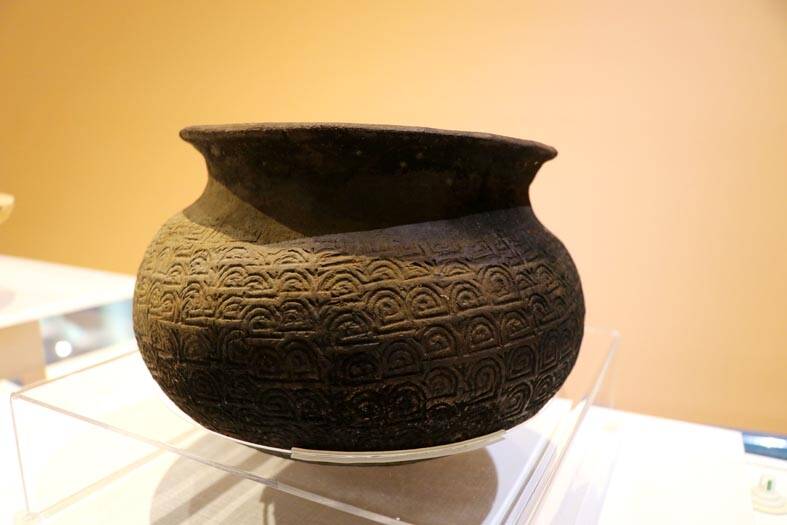The People’s Republic of China (PRC) yesterday paraded its military hardware in an effort to impress its own population, intimidate its enemies and rewrite history. As always, this was paced by a blizzard of articles and commentaries in the media, a reminder that Beijing’s lies must be accompanied by a bodyguard of lies.
A typical example is this piece by Zheng Wang (汪錚) of Seton Hall in the Diplomat.
“In Taiwan, 2025 also marks 80 years since the island’s return to China at the end of the war — a historical milestone largely omitted in official commemorations.”

Photo courtesy of the Shihsanhang Museum of Archaeology
The reason for its “omission” is that it never occurred. Taiwan was never returned to China. No doubt heads will nod at learning that Dr Wang is a Global Fellow at the Kissinger Institute on China and a member of the pro-PRC National Committee on United States-China Relations (NCUSCR).
The parade was a good example of how the PRC both exploits and reconstructs real history and creates fantasy history to support its expansionist dreams. These impulses also intersect in its treatment of Taiwan’s indigenous peoples.
FALSE HISTORY
Last year the Fujian government announced the opening of a museum dedicated to Austronesian peoples. “New Museum Shines Light on Origins of Austronesian Family,” it proclaimed. The use of “family” tracks the PRC’s propaganda line that Taiwanese and Chinese are one “family.” The museum features artifacts from the Keqiutou (殼丘頭) site, “one of the earliest Neolithic shell midden sites discovered along the coastal areas of Fujian.”
The museum was then leveraged to further the PRC narrative about alleged links between ancient Fujian and Taiwan. Officials said that the “Keqiutou site provides concrete evidence of the shared roots between Fujian and the island of Taiwan.”
The museum opening also featured comments from Tsang Cheng-hwa (臧振華), director of the Institute of Anthropology at Tsing Hua University in Taiwan.
“I believe the local government can leverage this platform to promote further scholarly exchanges between the two sides of the Taiwan [Strait],” he was quoted as saying.
The site’s usefulness in promoting Taiwan-PRC links is probably why it was named one of the top 10 archaeological sites in the PRC in 2023, according to English-language news channel of state-run China Global Television Network (CGTN), which forwarded the PRC faux historical view that “the artifacts are similar to those found at the [Dapenkeng] (大坌坑) ruins in Taiwan and are believed to be the home of the ancestors of the Austronesians.”
Keqiutou is located on Pingtan Island. Pingtan has another key link to Taiwan: it is where the PRC has sited a pilot zone with tax and investment breaks intended to steal technology and skilled workers from Taiwan, or “furthering cross-strait integration” as the PRC calls it. The PRC constantly fosters links between Fujian and Taiwan. Readers may recall that the noxious services pact, defeated by the Sunflower movement protests in 2014, treated Taiwan as part of Fujian province.
Pingtan inked “sister museum” agreements with institutions including the Bowers Museum (to which it is lending artifacts), the Museum of Tahiti and The Islands and the museum of New Caledonia. Obviously the PRC plans to use its faux Austronesian connection to further its ambitious goals of dominating the Pacific. With the Pacific island, will the PRC follow its traditional path of declaring a people “Chinese” and then seeking to annex their territory? Stay tuned for the next 20 years.
CONJECTURED PASTS
The certainty of PRC scholars notwithstanding, the relationship between the Pingtan site and Taiwan’s peoples remains a matter of conjecture. For one thing, scholars have yet to identify any ancestral culture for Taiwan’s Austronesian peoples in China. The sites on the mainland of Asia that may be related to Taiwan — note how the use of “southern China” or “Fujian” to describe the area both exploits and normalizes “China” as a thing that projects back into the past, unbroken — simply appear in the archaeological record without precursors, suggesting they are imports from elsewhere. Archaeologists do not know their origin. Kequitou, sometimes associated with the Dapenkang culture of northern Taiwan, may not be related at all to Austronesian cultures, or it may be the result of Austronesian-related peoples from abroad re-establishing themselves on the Asian mainland.
Moreover, the PRC “scholars” espouse a single migration model under which the Austronesians in Taiwan have an identifiable homeland on the mainland of Asia and arrived in a single migration. This model may well be false. Roger Blench has argued extensively that the Austronesians in Taiwan are a mixed group, the result of multiple migrations from along the coast of the Asian mainland, and that there was no single proto-Austronesian language that gave rise to the current indigenous language families on Taiwan. Note too that DNA studies indicate that some indigenous Taiwan groups are probably back-migrated from Philippines.
The PRC’s reconstruction of indigenous history is of course a component of its larger goal of constructing a fantasy history of Taiwan and using that narrative to advance its goal of annexing the island. The distortion of local archaeological findings shows the depth of that false narrative: the links between “China” and Taiwan created by the PRC extend downward through human history, to the very beginnings of people in Taiwan, unbroken.
But in reality, they don’t. There were people here before the Austronesians.
As we (and presumably PRC “scholars”) know, the PRC narrative has been adumbrated by the identification of Negrito remains in Taiwan (see the excellent book Seeking the koko’ ta’ay, edited by Tobie Openshaw and Dean Karalekas). These remains predate the appearance of Austronesian people on Taiwan. Because Negritos came up to Taiwan from the southeast (they are still found in southeast Asia today), they decisively negate the PRC’s attempt to reconstruct Taiwan as “Chinese” since all its peoples came from there.
Moreover, the great age of sites in the Philippines, on the island of Sulawesi and elsewhere in southeast Asia show that people of the genus Homo were crossing water and building communities thousands of years before the first Austronesians saw the Taiwan coast. The recent identification of a jawbone found in the Taiwan Strait as Denisovan, a wide-ranging modern human group that left genetic markers from Siberia through Laos down to Australia, strongly suggests this (in fact, the Ayta people of Philippines have the highest level of Denisovan genes currently known). It is thus difficult for this writer to believe that genus Homo was making tools in Sulawesi 1.5 million years ago, but the Negritos were the first people to reach Taiwan.
Speaking of the Kequitou site at the museum opening, Zhou Zhenyu, director of the Human Origins and Evolution Research Center at the Institute of Archaeology of Chinese Academy of Social Sciences, said: “Looking ahead, we will continue with archaeological work not just in Pingtan or Fujian Province, but across the entire southeastern coastal region to promote research and exploration on a broader scale.”
The archaeology of the entire region is going to be distorted to support Beijing’s territorial expansion. The proper response to that isn’t denial, but complexification. “But muh Austronesians from Fujian…” should be met with “Have you seen this Denisovan jawbone...?”
Notes from Central Taiwan is a column written by long-term resident Michael Turton, who provides incisive commentary informed by three decades of living in and writing about his adoptive country. The views expressed here are his own.

The Taipei Times last week reported that the rising share of seniors in the population is reshaping the nation’s housing markets. According to data from the Ministry of the Interior, about 850,000 residences were occupied by elderly people in the first quarter, including 655,000 that housed only one resident. H&B Realty chief researcher Jessica Hsu (徐佳馨), quoted in the article, said that there is rising demand for elderly-friendly housing, including units with elevators, barrier-free layouts and proximity to healthcare services. Hsu and others cited in the article highlighted the changing family residential dynamics, as children no longer live with parents,

It is jarring how differently Taiwan’s politics is portrayed in the international press compared to the local Chinese-language press. Viewed from abroad, Taiwan is seen as a geopolitical hotspot, or “The Most Dangerous Place on Earth,” as the Economist once blazoned across their cover. Meanwhile, tasked with facing down those existential threats, Taiwan’s leaders are dying their hair pink. These include former president Tsai Ing-wen (蔡英文), Vice President Hsiao Bi-khim (蕭美琴) and Kaohsiung Mayor Chen Chi-mai (陳其邁), among others. They are demonstrating what big fans they are of South Korean K-pop sensations Blackpink ahead of their concerts this weekend in Kaohsiung.

Oct 20 to Oct 26 After a day of fighting, the Japanese Army’s Second Division was resting when a curious delegation of two Scotsmen and 19 Taiwanese approached their camp. It was Oct. 20, 1895, and the troops had reached Taiye Village (太爺庄) in today’s Hunei District (湖內), Kaohsiung, just 10km away from their final target of Tainan. Led by Presbyterian missionaries Thomas Barclay and Duncan Ferguson, the group informed the Japanese that resistance leader Liu Yung-fu (劉永福) had fled to China the previous night, leaving his Black Flag Army fighters behind and the city in chaos. On behalf of the

I was 10 when I read an article in the local paper about the Air Guitar World Championships, which take place every year in my home town of Oulu, Finland. My parents had helped out at the very first contest back in 1996 — my mum gave out fliers, my dad sorted the music. Since then, national championships have been held all across the world, with the winners assembling in Oulu every summer. At the time, I asked my parents if I could compete. At first they were hesitant; the event was in a bar, and there would be a lot